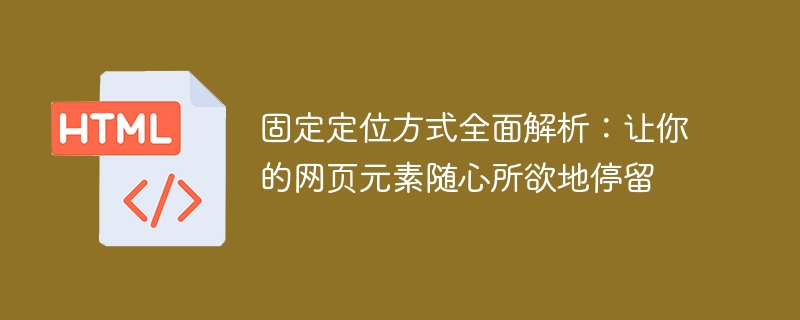

Comprehensive analysis of fixed positioning methods: Let your web page elements stay wherever you want, you need specific code examples
With the continuous development of the Internet, web design is becoming more and more Focus on user experience. In web design, fixed positioning is a very common technique that allows certain elements to remain in a fixed position as the page scrolls, providing a better navigation and browsing experience. This article will introduce the principle and implementation method of fixed positioning in detail, and provide some specific code examples for readers' reference.
1. The principle of fixed positioning
Fixed positioning is a positioning method based on CSS. By setting the CSS attribute of the element, it is separated from the document flow and always remains specified in the browser window or specific container. The position does not change as the page scrolls. This method can be used to implement fixed navigation bars, sidebars, advertising banners and other elements so that they are always visible when users browse the web, making it convenient for users to use and operate.
2. How to implement fixed positioning
3. Specific code examples
The following are some specific code examples for readers’ reference:
Example 1: Fixed top navigation bar
HTML code:
<nav class="navbar">
<ul>
<li><a href="#">首页</a></li>
<li><a href="#">产品</a></li>
<li><a href="#">解决方案</a></li>
<li><a href="#">联系我们</a></li>
</ul>
</nav>CSS code:
.navbar {
position: fixed;
top: 0;
left: 0;
width: 100%;
background-color: #f5f5f5;
padding: 10px;
z-index: 999;
}Example 2: Fixed right ad banner
HTML code:
<div class="sidebar">
<ul>
<li><a href="#"><img src="/static/imghw/default1.png" data-src="ad1.jpg" class="lazy" alt="广告1"></a></li>
<li><a href="#"><img src="/static/imghw/default1.png" data-src="ad2.jpg" class="lazy" alt="广告2"></a></li>
<li><a href="#"><img src="/static/imghw/default1.png" data-src="ad3.jpg" class="lazy" alt="广告3"></a></li>
</ul>
</div>CSS code:
.sidebar {
position: fixed;
top: 50%;
right: 10px;
transform: translateY(-50%);
z-index: 999;
}
.sidebar ul {
list-style: none;
padding: 0;
}
.sidebar li {
margin-bottom: 10px;
}Through the above code example , we can implement fixed positioning of the top navigation bar and right advertising strip.
Summary:
Fixed positioning is a very practical web design technology that can keep web page elements in a fixed position when scrolling, providing a better user experience. By setting attributes such as position, top, right, bottom, left and z-index, we can flexibly achieve fixed positioning effects. Readers can refer to the sample code in this article to adjust and use it according to their own needs and actual conditions. I hope this article will be helpful to readers in understanding and applying fixed positioning technology.
The above is the detailed content of Completely parsing fixed positioning: a way to achieve free stay of web page elements. For more information, please follow other related articles on the PHP Chinese website!
 mysql default transaction isolation level
mysql default transaction isolation level
 What is digital currency
What is digital currency
 The difference between arrow functions and ordinary functions
The difference between arrow functions and ordinary functions
 Clean up junk in win10
Clean up junk in win10
 special symbol point
special symbol point
 What keys do arrows refer to in computers?
What keys do arrows refer to in computers?
 How to use the Print() function in Python
How to use the Print() function in Python
 There is an extra blank page in Word and I cannot delete it.
There is an extra blank page in Word and I cannot delete it.




